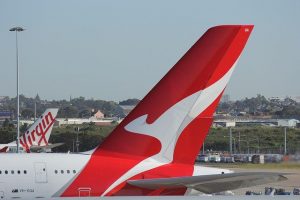 Ever wonder why airplanes have a vertical tail? Wings, of course, are horizontal to create lift, so conventional wisdom may lead you to believe that a horizontal tail is more effective than a vertical tail. While airplanes often have horizontal flaps on the tail, they also have a long and vertical tail structure known as a stabilizer. Also known simply as a fin, the stabilizer points upwards to provide stability. To learn more about the purpose of the stabilizer and why it’s used on so many airplanes, keep reading.
Ever wonder why airplanes have a vertical tail? Wings, of course, are horizontal to create lift, so conventional wisdom may lead you to believe that a horizontal tail is more effective than a vertical tail. While airplanes often have horizontal flaps on the tail, they also have a long and vertical tail structure known as a stabilizer. Also known simply as a fin, the stabilizer points upwards to provide stability. To learn more about the purpose of the stabilizer and why it’s used on so many airplanes, keep reading.
What Is a Vertical Stabilizer?
The vertical stabilizer is an airplane component that many people simply refer to as a “vertical tail.” It’s located on the aft of an airplane’s fuselage where it extends vertically. Unlike the wings, the vertical stabilizer doesn’t create lift. Instead, it lives up to its namesake by stabilizing the airplane.
Airplanes are typically designed to mimic the natural flight mechanics of birds. Birds have wings that, like an airplane’s wings, create lift as they fly. When a bird flies, air flows over its wings to create lift. Airplanes use this same mechanic by relying on horizontal wings to create lift. With that said, most birds don’t have a vertical tail. As a result, you might be wondering why airplanes need a vertical tail.
For starters, birds can stabilize themselves during flight by changing the shape of their wings. They have adaptive wings, meaning they can manipulate the shape of their wings to stabilize their body during flight. Airplanes, on the other hand, don’t have adaptive wings, so they can’t change the shape of their wings during flight. And without adaptive wings, airplanes rely on a stabilizer to stabilize themselves during their flight.
Birds can also change the position of their head to stabilize their body. Airplanes, on the other hand, have a fixed nose that cannot change shape. Regardless, airplanes typically need a vertical stabilizer to stabilize themselves during flight. If an airplane encounters strong winds, the vertical stabilizer will prevent it from shifting off under the force of the wind.
In Conclusion
Technically, airplanes don’t have a vertical tail; they have a vertical stabilizer, which is found on the tail. The purpose of the vertical stabilizer is to stabilize the airplane during flight. It helps to control airplanes so that they aren’t adversely affected by strong winds. Hopefully, this gives you a better understanding of the vertical stabilizer.



